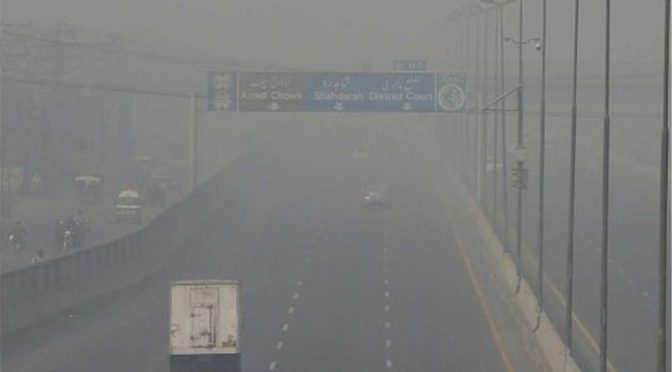LAHORE: Lahore continues to make headlines as, with the air quality index (AQI) recorded at 485, it was ranked as the second-most polluted city in the world on Monday.
Citizens, however, were able to see a blue sky on Monday morning as there was an improvement in pollution levels due to a change in wind direction and cloud seeding.
The air quality in Lahore fell below the threshold considered “hazardous” for humans for the first time in two weeks on Sunday, and the situation was better on Monday as compared to the past several weeks when the AQI crossed the alarming level of over 1,000.
The AQI reached a daily average of 243 on Sunday, still “very unhealthy” but below the highest level of 300 considered “hazardous.”
The level of PM2.5 particles was also more than 10 times higher than the level deemed acceptable by the World Health Organization (WHO).
The city of 14 million people, close to the border with India, peaked at a record AQI of 1,110 on November 14.
Punjab, home to more than half of Pakistan’s 240 million people, closed schools in its major cities on November 6 and, on Friday, extended the closure to November 24.
It has also banned all outdoor sports in schools until January and cracked down on polluting tuk-tuks, barbecues, and construction sites in pollution hotspots across Lahore.
Seasonal crop burn-off by farmers on the outskirts of the city also contributes to toxic air, which the WHO says can cause strokes, heart disease, lung cancer, and respiratory diseases.
On the other hand, although smog in Islamabad was not as thick as it was in Lahore, the AQI in the city was not healthy either, as it was recorded at 119, which is 8.6% more than the standard set by the WHO.
Doctors said the weather conditions posed a threat to the health of asthma patients. Smog again led to the closure of different sections of the motorways. M-11, connecting Lahore to Sialkot, M-4, from Kot Abdul Hakim to Multan, and M-5, from Multan to Sukkur, were all closed for traffic.
Meanwhile, the restrictions imposed by the Punjab government in view of smog remain in place as parks and other places of recreation, such as museums, zoos, historical sites, and schools, will remain closed until November 24.
Similarly, the schedule announced for the opening and closure of commercial markets will be applied until November 24.
It is pertinent to mention here that while smog levels have dropped at present, the National Disaster Management Authority (NDMA) has warned of heightened smog levels across several cities in Pakistan during November and December, urging citizens to take precautions to minimize health risks.
The advisory highlights Lahore, Faisalabad, Multan, Bahawalpur, Peshawar, Nowshera, and Mardan as the most affected areas, with peak smog levels anticipated during morning and evening hours. The NDMA has recommended wearing masks and avoiding unnecessary travel to mitigate exposure to harmful pollutants.
On the other hand, the Punjab government, on November 16, declared a health emergency and a three-day lockdown in Lahore and Multan, besides a series of emergency measures to mitigate the smog [crisis] that turned into a health crisis.
Addressing a press conference on Friday, Punjab Senior Minister Marriyum Aurangzeb had announced a series of emergency measures in response to the worsening smog crisis in the province, including the declaration of a health emergency and a three-day lockdown in Lahore and Multan.
She stated that a health emergency was declared in Lahore and Multan, and leaves of all doctors and paramedical staff were canceled, while the closure of schools and colleges was also extended for one more week.
Due to the smog, schools will be closed for this whole week too, and online classes will be held in colleges and universities. Restaurants have been given time till 4 PM; however, taking food from restaurants will be allowed till 8 PM.
“A new campaign, named ‘Detox Lahore,’ will be launched to address the smog crisis. Restaurants will be restricted to takeaway services after 4 PM, and brick kilns and furnace-based industries will remain closed for a week,” Aurangzeb said.
Aurangzeb emphasized that smog is not a short-term issue, and the government is preparing three-month action plans to tackle the crisis over the next year. She referred to smog as a national disaster affecting not just Lahore but also Abbottabad and Multan.
Moreover, the minister announced the following measures in view of the worsening smog in Lahore and other cities of Punjab: All brick kilns and furnace-based plants in Lahore and Multan have been shut down from Friday to curb emissions.
A complete lockdown will be enforced on Friday, Saturday, and Sunday if the situation does not improve by Wednesday. Dining in at restaurants will be allowed only until 4 PM, after which takeaway services will be permitted.
Earlier, on November 12, satellite images from NASA’s Worldview had shown the extent of the smog, which blankets not only Lahore but also northern India. The hazy skies have obscured buildings and streets, with both Lahore and New Delhi clearly visible in the satellite imagery, engulfed in a thick layer of smog.
Lahore has topped the global list of the most polluted cities, according to Swiss air quality technology company IQAir, which reported the city’s AQI as extremely hazardous.





















